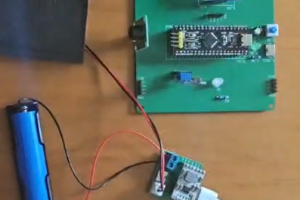设计说明书
总字数:16000+
摘要
随着智能家居理念的普及和人们对居住环境舒适度、节能性要求的提升,传统手动控制的灯光系统已难以满足现代生活的需求。打造一种能够根据环境变化和人体活动自动调节,同时具备手动参数设置功能的智能灯光控制系统,成为改善居住体验、实现节能目标的重要方向。
本设计提出了一种基于 STM32F103C8T6 单片机的智能家居灯光控制系统。系统核心功能包括:通过 5516 光照检测模块实时采集当前环境的光照强度数据;借助 D203S 人体热释电模块判断监测区域内是否有人活动;当检测到人且环境光照强度处于 “大于最小值且小于最大值” 的区间时,系统控制 RGB 灯模块发出黄光;当检测到环境光照强度大于最大值时,RGB 灯模块切换为发出白光;同时,通过 OLED 液晶显示模块直观展示当前的光照强度、人体检测状态以及灯光工作模式等监测数据;用户还可通过按键对光照强度的阈值等监测参数进行灵活设置,以适配不同的使用场景。在供电方面,系统采用太阳能板为锂电池充电,再由锂电池为整个控制系统提供稳定电力,兼顾节能与可持续性。
该智能家居灯光控制系统的应用价值在于,实现了灯光的智能化、自动化控制,既减少了人为操作的繁琐,又能根据实际环境与人体活动情况合理调节灯光,有效降低能源消耗。同时,参数可设置的功能提升了系统的灵活性和适配性,为用户营造更加舒适、便捷且节能的居住环境,推动智能家居生活的进一步普及。
关键词:STM32F103C8T6 单片机;智能家居;灯光控制;光照检测;人体检测
Design of Smart Home Lighting Control
Abstract
With the popularization of smart home concepts and the increasing demand for comfortable and energy-efficient living environments, traditional manually controlled lighting systems are no longer able to meet the needs of modern life. Creating an intelligent lighting control system that can automatically adjust based on environmental changes and human activities, while also having manual parameter settings, has become an important direction for improving the living experience and achieving energy-saving goals.
This design proposes an intelligent home lighting control system based on STM32F103C8T6 microcontroller. The core functions of the system include: real-time collection of current environmental light intensity data through the 5516 light detection module; Use D203S human thermoelectric module to determine whether there is human activity in the monitoring area; When a person is detected and the ambient light intensity is within the range of “greater than the minimum value and less than the maximum value”, the system controls the RGB light module to emit yellow light; When the ambient light intensity is detected to be greater than the maximum value, the RGB light module switches to emit white light; At the same time, the OLED LCD display module intuitively displays monitoring data such as current light intensity, human detection status, and lighting working mode; Users can also flexibly set monitoring parameters such as light intensity thresholds through buttons to adapt to different usage scenarios. In terms of power supply, the system uses solar panels to charge lithium batteries, which then provide stable power to the entire control system, balancing energy conservation and sustainability.
The application value of this smart home lighting control system lies in the realization of intelligent and automated control of lighting, which not only reduces the complexity of human operation, but also adjusts the lighting reasonably according to the actual environment and human activity, effectively reducing energy consumption. Meanwhile, the adjustable parameter function enhances the flexibility and adaptability of the system, creating a more comfortable, convenient, and energy-efficient living environment for users, and promoting the further popularization of smart home living.
Keywords:STM32F103C8T6 microcontroller; Smart home; Lighting control; Light detection; Human body detection.
目 录
1 绪论
1.1 研究背景及意义
1.2 国内外研究现状
1.3 主要内容
2 系统总体方案设计
2.1系统总体设计
2.2 主要模块方案选择
3 系统硬件设计
3.1 总体硬件框架
3.2 主控模块电路设计
3.3 光照检测模块电路设计
3.4 人体检测模块电路设计
3.5 显示模块电路设计
3.6 按键模块电路设计
3.7 RGB 灯模块电路设计
3.8 太阳能供电模块电路设计
4 系统程序设计
4.1 编程软件介绍
4.2 系统主流程设计
4.3 独立按键
4.4 OLED显示流程设计
4.5 光照检测模块子流程设计
4.6 人体热释电感应模块子流程设计
5 实物制作与功能测试
5.1 实物制作
5.2 光照检测与显示功能测试
5.3 人体检测与灯光控制功能测试
5.4 按键参数设置功能测试
5.5 太阳能供电功能测试
6 总结
参考文献
致谢
附录A 原理图
附录B PCB
附录C 主程序
购买后可查看具体内容!

